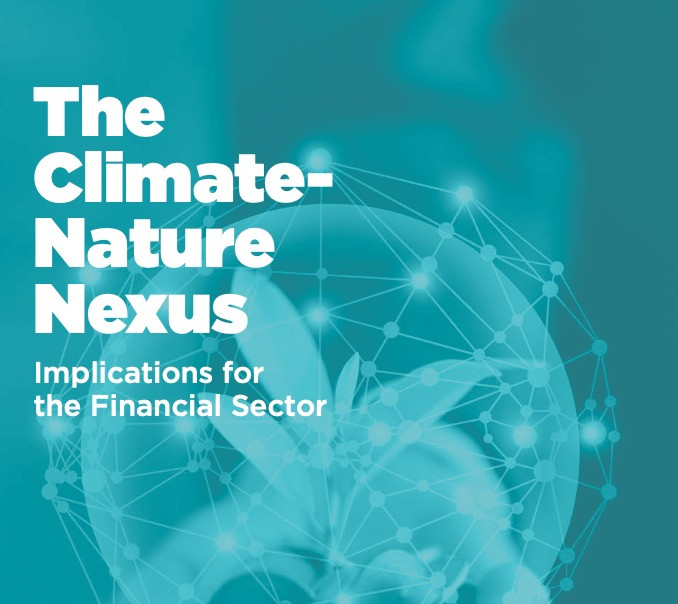Material Risks and Opportunities of Climate-Nature Nexus
Updated: Jun 8

NEW REPORT URGES FINANCIAL INSTITUTIONS TO CONSIDER MATERIAL RISKS AND OPPORTUNITIES OF CLIMATE-NATURE NEXUS
The finance sector has started to act on climate, but new report urges financial institutions to adapt climate approaches to address nature risks and opportunities at the same time.
Urgent attention needed to repair traditional risk categories used by financial institutions; without this, leaders cannot systematically address threats like the climate or biodiversity crises.
Report release is in advance of the Taskforce for Nature-related Financial Disclosures (TNFD) – a new global framework for companies and investors to report and act on nature-related risks – expected to be launched in early June.
LONDON, Thursday 27 May 2021 - A new report from the Finance for Biodiversity Initiative (F4B) details why and how climate and nature impacts must be considered together, and not in isolation. The findings laid out in the report, The Climate-Nature Nexus: Implications for the financial sector assert that a future that deals with both the nature and biodiversity crises will be very different to one that deals with climate alone. The risks, solutions, and opportunities for the financial sector all change. But the majority of the financial sector has already started acting on climate, and can leverage this to make quick progress on nature.
Today’s report reiterates the importance of financial institutions considering material climate and nature risks in parallel, particularly in sectors such as agriculture, fisheries, and forestry. By considering only climate, the market values of bioenergy, large infrastructure projects and low-carbon materials in 2050 are likely to be overestimated, as this does not account for their damage to nature. Gross domestic product (GDP) growth in the agriculture sector alone is inflated by an estimated US$1.9 trillion, and current market expectations for new sectors like bioenergy could be overstated by a factor of 30.
Building on the rapidly growing body of work on nature and its interactions with climate, the report sets out four key recommendations to guide global finance in leveraging climate to better manage nature. These include:
Lowering the threshold for mitigating action in sectors with extreme climate and nature risks;
Engaging investees to account for nature-driven risks in cashflow projections;
Deploying available nature impact metrics into investment procedures; and
A major global push to screen climate-aligned portfolios for high-risk, nature negative implications.
Philippe Zaouati, Chief Executive Officer, Mirova said: “At Mirova, we consider both climate and nature-related risks and opportunities as the heartland of tomorrow’s global economy - it is one of the foundations of our investment landscape. So we welcome Finance for Biodiversity’s report that focuses the wider investment community on this climate-nature nexus, and likewise encourages policy makers and regulators to act in shaping and so making this landscape more attractive to us all."
Deborah Lehr, Vice Chairman and Executive Director of the Paulson Institute added: “Building on the Paulson Institute’s work on climate and green finance, we are deeply committed to advancing practical approaches for the market to deal with related nature risks and opportunities. This report takes us a long way in clarifying and quantifying the space where we all need to invest more time, energy, and of course finance."
The second joint Paulson Institute/F4B ‘Finance for Nature’ event will be taking place on Thursday 24 June, and will focus on the findings of today’s paper.
Carlos Manuel Rodríguez, Chief Executive Officer and Chairperson, Global Environment Facility (GEF) said: “Consumers, stakeholders, and governments expect financial institutions and CEOs to take action which halts the loss of nature. Redirecting capital flows from nature negative to nature positive is a necessary component in shifting global systems towards protecting and nurturing nature. Using climate as an entry point is a powerful and necessary way to catalyse this. Investing in nature is cost-efficient, and the returns will be long lasting.”
Dr Bruno Oberle, Director General, International Union for Conservation of Nature (IUCN) said: “Nature and climate are two sides of the same coin. This is something IUCN has long known, and that science clearly shows. However, there is still a lack of global action that adequately deals with the biodiversity and climate crises. We must raise investors’ awareness of these dynamics in their financing decisions, and Finance for Biodiversity’s report goes a long way in helping to do just that."
Simon Zadek, Chair of F4B, concluded: “Finance for Biodiversity is committed to making nature related risks and opportunities material in private and public financing decisions. Building bridges between the effective management of climate and nature will help those already working on climate in their financing decisions to build out a focus on nature, and vice versa, whilst pointing to where policy makers, regulators, and standard setters can helpfully join the dots.”
Please read the full Climate-Nature Nexus report here